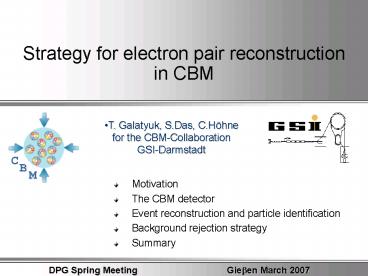Strategy for electron pair reconstruction in CBM - PowerPoint PPT Presentation
1 / 16
Title:
Strategy for electron pair reconstruction in CBM
Description:
Probes for hot / dense medium. The phase diagram of the strongly ... Vector mesons (?, ?, f) are the only mesons that directly couple to the e.m. current ... – PowerPoint PPT presentation
Number of Views:18
Avg rating:3.0/5.0
Title: Strategy for electron pair reconstruction in CBM
1
Strategy for electron pair reconstructionin CBM
T. Galatyuk, S.Das, C.Höhnefor the
CBM-Collaboration GSI-Darmstadt
- Motivation
- The CBM detector
- Event reconstruction and particle identification
- Background rejection strategy
- Summary
DPG Spring Meeting
Gieben March 2007
2
Probes for hot / dense medium
The phase diagram of the stronglyinteracting
matter in the T rB plane
- Virtual photons can probe the electromagnetic
structure of nuclear matter under extreme
conditions - The produced dileptons can escape the medium
essentially undistorted - Vector mesons (?, ?, f) are the only mesons that
directly couple to the e.m. current - By means of their 4-momentum, dileptons provide
information about the parent particle.
? meson is of particular interest ?? ltlt
?fireball (1.3 fm/c ltlt 10 fm/c)
3
Vector meson spectral function
vacuum
nuclear medium
Mass dependence of the electromagnetic form
factor of the pion
R.Rapp (hadronic many-body approach)
Strength of dilepton yield at low invariant
masses is due to coupling to baryons
4
Electron setup of the CBM detector
ECAL
- STS tracking, momentum determination, vertex
reconstruction - Active Shielding Magnetic Field
- RICH TRD ( ECAL) electron ID,p suppression ?
104 - TOF ( RICH) hadron ID
- ECAL direct photons p0 and ? e, µ
- high speed DAQ and trigger
- 600 charged particles in the acceptance
TOF
TRD
RICH
magnet
STS
There is no detector system which can provide
electron ID before the magnetic field!
5
Background sources of ee-
AuAu collision at beam energy 25AGeV, zero
impact parameter
Radial vs. z position (e?) andBy along the beam
axis
3 ?target? ee-
700 p/- can be identified as an electron
6
Tracking performance
Reconstruction efficiency
Momentum resolution
94 track reconstruction efficiencyMomentum
resolution well below 2
7
Electron identification with RICH, TRD, TOF
Ring radius vs. momentum
55 electron efficiencyp-suppression of 104
well in reach
8
Track topology
Global Track
fake pair
signal
Track Fragment - x, y position no charge
information Track Segment - reconstructed
track Global Track - identified in RICH
9
? conversion rejection
Correlation of the number of STS traversedby
ee- pairs from g conversion
10
?e,reco track vpeprec track correlation
Track Segment
Global Track
ep0 closest track
er closest track
11
Invariant mass spectra
Identified ee-
After all cuts applied
combinatorial bg
combinatorial bg
?
p0
?
?
?
?
No optimization of cuts Free cocktail only
(without medium contribution) Simulated
statistics is equivalent is to 1 spill beam on
target
12
Phase space coverage
pt vs. rapidity distribution of reconstructed ?0
meson after all cuts applied
Signal efficiency 8 No phase space limitation!
13
Invariant mass spectra (generic study)
Accepted in RICH ee-
After all cuts applied
combinatorial bg
combinatorial bg
?
p0
?
?
?
?
More than two orders background suppression in
the intermediate mass region! Signal-to-background
ratio 200 MeV lt mee lt 600 MeV is 1/10
14
Difference between generic and full MC study
- Distance between neighboring hits in STS 1 was
applied - excellent double-hit resolution
(lt100mm) provides substantial close pair
rejection capability.
- Rejection of the conversion can be further
improved by exploiting energy loss information - A realistic concept to suppress the field between
the target and first MVD station has to be worked
out.
15
Summary
- We presented simulated dielectron invariant mass
spectra after full event reconstruction and
particle identification including realistic
detector responses - Sufficient rejection power by using topological
cuts in the given CBM geometry - Statistic of the simulated data is equivalent to
1spill of data taken (archive data rate 104
evt/sec)
16
Thank you






























